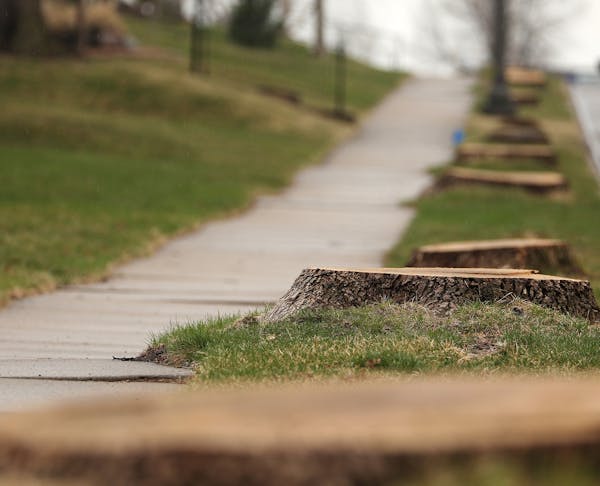If thousands of ash trees are cut down in St. Paul, leaving blocks of ugly stumps behind to remind angry neighbors of what they've lost, does it make a sound?
Apparently, yes, quite a loud one. And St. Paul City Council members heard it, by phone, by e-mail and on social media.
On Wednesday, the council voted 5-1 to add $450,000 to the budget for tree removal and replanting, enough to get rid of all the ash tree stumps left behind by a budget shortfall and plant news trees in their place. The stumps should start coming out this summer, said Parks and Recreation Director Mike Hahm and new trees will begin to be planted in the fall and spring.
Council members said leaving behind block after block of ash tree stumps was not what they or their constituents wanted. But the emerald ash borer infestation that first appeared in St. Paul in 2009 has accelerated so rapidly and over so much of the city, that money budgeted to remove trees and stumps and plant new shade tree varieties was blown through just removing thousands more trees than expected.
Rather than wait until next year to chip up the stumps and plant replacements, Council Member Amy Brendmoen said that she and her colleagues found money in the budget to do it sooner. The $450,000 will be transferred to the emerald ash borer program from contingency funds in the city's capital improvement budget.
"This is a part of tree removal that is necessary," said Brendmoen, who co-sponsored the budget resolution with Chris Tolbert, Dai Thao and Jane Prince. "Not doing it is like doing a street reconstruction and saying we're going to wait a year to put down the pavement. Leaving that project [unfinished] is unacceptable."
Said Prince: "It wasn't right to leave it looking like that."
Just before the council voted Wednesday, Brendmoen thanked the city's district councils and a burgeoning number of city residents for calling the issue of the left-behind stumps to her attention. By phone, e-mail and Facebook conversations, people all over the city have lamented the loss of their ash trees and expressed their disappointment with having to look at stumps where beautiful trees once stood.
While it can take up to two generations to restore a lost urban tree canopy, Brendmoen said the city's move Wednesday will get it started a bit sooner.
Hahm said the council's action will help the city get back to instituting its complete program of "cutting, stumping and planting" where there were infested or threatened trees.
"This $450,000 should get us through 2017," Hahm said.
Budget crunch
Heading into 2017, St. Paul had budgeted just short of $1.3 million to address the city's emerald ash borer infestation. Mayor Chris Coleman had also allocated an additional $900,000, which was later placed into a contingency fund after the city learned it had to grapple with a budget hole of $30 million related to a Minnesota Supreme Court ruling on the St. Paul's street assessment program.
But it became clear pretty quickly that the money in the budget would not be enough to pay for the entire program, officials said. The number of infested trees has risen 400 percent compared to 2015, officials said. In fact, the words "crisis" and "catastrophe" have been used to describe the impact of the invasive species that is expected to cost St. Paul all of its 18,000 remaining boulevard ash trees.
In Minneapolis, where officials say they will eventually remove 40,000 ash trees from boulevards and public rights of way, the Park Board has budgeted more than $1.7 million for its ash borer program. A spokeswoman said that amount is expected to adequately cover removal of trees and stumps and planting new trees this year. So far in 2017, 3,000 public ash trees have been removed in the city of Minneapolis.
St. Paul officials have said that 95 percent of the city's neighborhoods have now been "directly impacted" by emerald ash borer. More than 9,000 public ash trees have been removed to date, with another 17,900 to go.
While Hahm said the city can soon start contracting with crews to remove the stumps, replacement tree planting will start in the fall. Fall and spring are the times when the city plants new trees, with the choice of season depending on the species of tree.
James Walsh • 651-925-5041

Minneapolis schools, teachers reach tentative agreement to avert strike
Men knock woman down and steal her dog during walk, St. Paul police say

Minneapolis reaches $150k settlement with eyewitness of George Floyd's murder
He grew up legally in Minnesota, but immigration law gap may one day force student to leave

